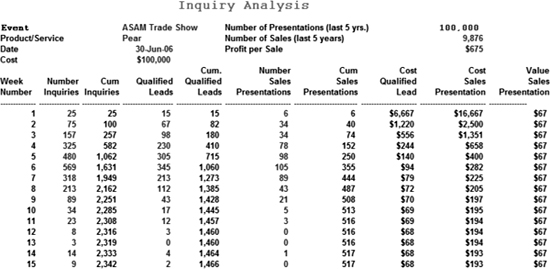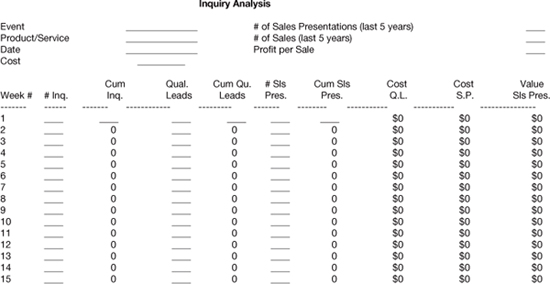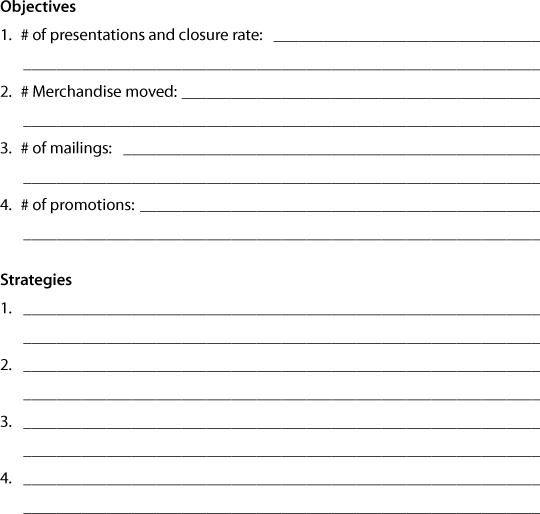10 The Sales Promotion Plan
There are many types of sales promotion. Following are the major ones.
![]() Price deals
Price deals
![]() Coupons
Coupons
![]() Samples
Samples
![]() Premiums
Premiums
![]() POP (point of purchase)
POP (point of purchase)
![]() Sweepstakes/contests
Sweepstakes/contests
![]() Promotions
Promotions
![]() Brochures
Brochures
![]() Direct mail
Direct mail
![]() Trade shows
Trade shows
Let’s take a look at them one by one.
Price Deals
The advantages of price deals are:
1. They can induce customers to try the product or service.
2. They can establish a purchase pattern.
3. They should increase sales.
4. They may neutralize competitive promotions.
The disadvantages of price deals are:
1. They don’t build loyalty.
2. They don’t reverse a declining sales trend.
3. They won’t change “non-acceptance” of a brand.
When you discount your price, make it a surprise; save discounts until your supplier does something special. Don’t use promotional discounts to sell in, but to sell through and position against the right type of customer.
Following is a chart that shows who buys your discounted merchandise.

Notice that 42 percent of the deal merchandise is bought by deal buyers, who most of the time will leave you as soon as you pull the promotion. The ideal promotion is one that is designed to attract the “not loyal to any brand” and “loyal to competition.” Usually a bigger than average discount will entice these two groups.
Coupons
Coupons can be an effective promotional tool. I buy all my office supplies, including electronic gear, from the local Office-Max, because they mail me $10- and $20-off coupons every other week. I also buy all my books at Barnes & Noble because they e-mail me similar coupons every few weeks. Try to be unique for maximum impact. A local car dealer ran a full-page newspaper ad with a coupon. The value was right out of the promotional book of Procter & Gamble. The value was 25 cents. The ad said you could now buy a $20,000 automobile for just 19,999.75. The promotion set sales records at the dealership. An ad for another car dealer showed all his cars hanging from a clothesline. Of course they were all white. The ad proclaimed it as the August White Sale, with a coupon below. The event was very successful. (People still notice clever.)
If you can possibly do so, use buy-back coupons. This is where the customer buys the product or service and then has to mail back the coupon to obtain her refund. It is a beautiful way to build your database. You then send out quarterly correspondence to these individuals hawking what you have to sell.
You should also check out electronic coupons. If you are a participant, as a customer’s merchandise gets scanned during checkout at a grocery store, if they have purchased a competing brand, out pops your own coupon. This eliminates the cost of giving coupons to people who would have purchased your brand without the coupon. And it induces that customer to give your version of the same product a whirl. Who knows, she may become a loyal customer.
Samples
Research indicates that sampling is the best way to achieve product trial or first-time buying. Procter & Gamble has been using this approach for years. Recently other types of businesses have used sampling. Right now you can purchase a General Motors automobile, drive it for sixty days, and if you don’t want to keep it, you can return the car and get all your money back. This strategy was originated by Lee Iacocca at Chrysler years ago and everybody thought he was nuts, but few people returned the car. Today, many companies send you a sample of what they are selling for a free trial period, usually for between thirty and ninety days. In most cases, you can keep the sample even if you don’t agree to sign up for their program.
Premiums
McDonald’s is the king of premiums. They are constantly offering premiums that the kids love and consequently, it brings in the whole family. Be sure your premium is desirable to a member of your target audience and can’t be obtained anyplace else. You may want to offer a self-liquidating premium in your ads. This is the type you offer at a very low price and where customers send money and vouchers or proof of purchase to obtain a premium gift. American Express does this all the time.
Effective premium strategies are not limited to consumer goods. A manufacturer of heavy earth-moving equipment mailed out miniature electric trains to prospective customers. In a series of mailings, the prospects received various train cars used for hauling, such as a tanker, then a caboose, and finally the engine. After the completion of the mailing, the manufacturer’s sales force had little problem setting up appointments with the recipients, especially the one-third that kept the complete train set on top of their desk.
Point of Purchase (POP)
A POP display can be a very effective sales tool because it’s located right next to the merchandise—but unless it’s unique and stands out from the competition, it won’t get you much of a bump. This is the mistake companies are making in grocery stores. Their self-talkers, the little posters attached near the merchandise, are all the same. When I worked on the Hamm’s Beer account, we put together a fifteen-foot-tall end-of-aisle display featuring the Hamm’s bear, who skated around on the fixture. We offered it to retailers for the weekend if they would purchase 200 cases of the beer. The demand was so great we had retailers standing in line for weeks.
If you are selling off shelves in retail stores, you want to take into account the physical challenges facing elderly shoppers. Drugstore chain Rite Aid is revising its private-label goods with bigger package fonts. Family Dollar is adapting new lighting and shelf labels. Walgreens plans to install call buttons near heavy merchandise like bottled water and laundry detergent and magnifying glasses on store shelves.
Sweepstakes and Contests
In a sweepstakes, you cannot force the participant to purchase your merchandise. That is because no skill is involved and it is thus considered a lottery, which is illegal for a for-profit company. However, you can require a purchase for a contest. Whether you choose a sweepstakes or a contest, the key question is always going to be “Who will participate?” You must structure your campaign so that your target audience is well represented among the participants.
As always, try to be unique. In 1995 Mars ran the M&M Color Campaign and collected millions of dollars in free publicity. Participants had the choice of selecting purple, blue, or pink as the color for the new variety of M&M. The announcement of the winning color—blue—was carried on most television networks. The company had the Empire State Building lighted in blue that night, resulting in wide print media coverage.
Promotions
As with all parts of your marketing plan, you want to be unique for maximum effectiveness. Burger King now has what they refer to as “Whopper Bars.” They are already operative in Germany, Singapore, and Venezuela and will be opening one in Miami’s South Beach and one in New York’s Times Square. The stores will be more modern, but the main difference is that beer will also be on the menu.
Holiday Inn now has live bed warmers for guests. Management will send a staff member in a fleece sleeper suit to warm a guest’s bed before they go to sleep. Bloomingdale’s flagship store on Lexington Avenue in New York City now has what they call “Big Window Challenge.” Each brand sponsors a window display that showcases a room featuring its own signature look, personality, and lifestyle. The winner was Eddie Ross, for Elle Décor, who presented “The Modern Woman,” a room that brings together vintage and modern colors, patterns, and details. An aura of happiness, confidence, and adventure permeates the room among hot pink candlesticks, an orange art deco painting, and twin turquoise blue lamps.
Brochures
Back in Chapter 1 we told you not to put a picture of the torsion spring manufacturing facility on the cover of your sales brochure. We repeat that admonition here: When you are writing a sales brochure, remember that you are not selling the building that contains your home office; please don’t put a picture of the building on the cover. As always, you lead with your benefits to get the reader to open up the brochure. I recently received a brochure from American Express. On the cover were the words, “Skyguide Executive Privilege Club.” The background was a rather boring series of plane outlines. On the inside of the brochure was a list of neat benefits. That’s OK if the person opens it, but this particular cover didn’t give you a good reason for doing so.
Another common mistake is putting the copy on the inside of the brochure in reverse (white copy on a dark background.) Doing this reduces your readership up to 80 percent. People do not like to read reverse copy. It is too hard on the eyes.
The companies that are doing it right are direct sales retailers with their mail catalogs. Among retailers who rely on direct sales, 62 percent say their biggest revenue generator is a paper catalog. “There will be some paper version for as long as I’m in the business,” says Steve Fuller, chief marketing officer for L.L. Bean.1
Direct Mail
The best combination for direct mail is a brochure, letter, and a postage-paid return postcard. The brochure and the letter should each tell the whole story, but in a different way. The postcard should have a couple of boxes to check. They could be “have a consultant call,” “send me more material,” and “not interested.” Use the word consultant rather than salesperson. Include a “not interested” box because if a postcard with this box checked is returned, it probably means the participant is in fact interested in your promotion (otherwise, why would they bother responding at all?) but that you are doing something wrong in the presentation.
Try to put a benefit next to the address on the envelope. For an insurance company, I put a picture of some children on the envelope with the words, “Protect your kids.”
Trade Shows
The software file TRADE.xls can be used to determine the effectiveness or value of your trade shows, brochures, coupons, or bingo cards (game cards). Ideally you would like to trace the specific type of activity relative to the number of sales consummated. Some companies can physically track a lead all the way to the eventual sale. However, many businesses, especially those marketing industrial products, cannot. They may talk to a prospect today and the sale will not be consummated for a year or two. Companies in this situation never really determine the true value of a particular trade show or brochure. They could be running trade shows or sending out brochures, using bingo cards, etc., for years and never know whether it is a losing proposition or not.
This model is based on the premise that practically all companies can trace their leads at least to the number of sales presentations that are eventually made. If you can do so, then you can place a value on each of the leads that you get from each of the preceding types of marketing communications activities and use that information to determine whether you should continue to employ a particular tactic.
Let’s take a look at the case history from CTRADE, shown in Figure 10–1. The particular event is a trade show and the cost is $100,000. The number of sales presentations that have been made by the sales force during the last five years is 100,000, and the number of sales that have been made during this same period is 9,876. All companies have this type of data and based on these figures, you can determine your “closure rate.” The “closure rate” is the percent of total sales presentations that are made that eventually result in a sale. For this particular company, if they have made 100,000 sales presentations over a period of years, and sales were 9,876, it means that the closure rate is slightly less than 10 percent. The next variable is the profit per sale. In this particular company, it’s $675.00. If the profit per sale is $675.00 and the sales force closes on approximately one out of ten sales presentations, then the value of a sales presentation is $67.00. This is shown in the column to the far right in the model.
Figure 10–1 Inquiry analysis (CTRADE).

For this trade show, the number of inquiries received by the company are shown by week in the second column, with the third column being a cumulative total. The fourth column is the number that will qualify. All leads should be qualified by some means; usually the best way is through telemarketing. That means someone in your company actually calls up the person who has submitted the lead to determine whether they are a member of the target audience. The next column is a cumulative total on the number of qualified leads. Following that is the number of sales presentations made. For example, the company sent out to the sales team fifteen of the qualified leads received from week one, and of those fifteen, the sales force was able to make presentations to six of them. During the second week, eighty-two qualified leads were sent out to the field, and the sales force was able to make thirty-four sales presentations.
The seventh column from the left gives you a cumulative total of the number of sales presentations followed by the cost per qualified lead, the cost for each sales presentation, and finally, the value per sales presentation as previously discussed. You will note that at the end of week 15, the cost for each of the sales presentations was $193, while the value of a sales presentation is only $67. Obviously, it’s not working for this particular company to participate in this trade show.
The cost of a sales presentation is determined by dividing the number of sales presentations that are actually made into the cost of the event, which in this particular case was $100,000. The sales force made 517 sales presentations and 517 divided into 100,000 is $193. The cost of sending the salesperson out to make the presentation is not included because the value of the sales presentation is based on the profit for selling each unit. This profit figure has already taken into account the costs of marketing.
The way to use this model is to adapt it to your various activities such as brochures, bingo cards, and trade shows, and determine which one is giving you the lowest cost on a sales presentation. Whenever you find an activity where the cost of a sales presentation is less than the value of a sales presentation, you’ve got yourself a winner.
Figure 10–2 depicts this particular case history as a graph. The value of a sales presentation is the horizontal line from the Y axis at $67. The cost of a qualified lead cuts below the value of a sales presentation after week 7. However, every qualified lead does not result in a sales presentation. The curve on the cost for a sales presentation gets no lower than $193, therefore, for this particular activity, the cost for each sales presentation is costing the company $193, and the value of each of these presentations is only $67. Obviously, this is a misuse of funds.
Figure 10–3 shows a copy of the inquiry analysis file from TRADE.xls where you can insert your own data. You will probably have to work with someone from accounting/finance to get meaningful data from a campaign your company has run. You may not be able to get the information in a usable form, but going forward, you know what you will need as per the data shown in the case history.
Figure 10–2 Cost versus value (CTRADE; Chart).

Figure 10–3 Your inquiry analysis (TRADE).

Objectives and Strategies
Following is a worksheet you can use to write your objectives and strategies for your entire sales promotion plan, with some suggested topics. You can substitute your own categories if these are not useful. Since you will be developing your objectives and strategies differently for each event, you will want to make as many photocopies of the worksheet (or printouts from the Worksheets folder) as you think you will need.
Be sure to make a list of your goals for each event or type of sales promotion identifying a specific business purpose with quantifiable objectives. “Sometimes people get so caught up in the event itself they forget what they’re seeking to accomplish there,” says Roger Dow, president and CEO of the U.S. Travel Association. “If you’re sending people to a trade show, have them list the top five clients they want to meet and their objective for each one. When they come back, ask them what actually happened and how their meeting will benefit the organization.
Worksheet 10–1 Sales promotion plan: Objectives and strategies

Note
1. Jeffrey Ball, “In Digital Era, Marketers Still Prefer a Paper Trail,” Wall Street Journal, October 16, 2009; http://online.wsj.com/article/NA_WSJ_PUB:SB125565110691488935.html.
